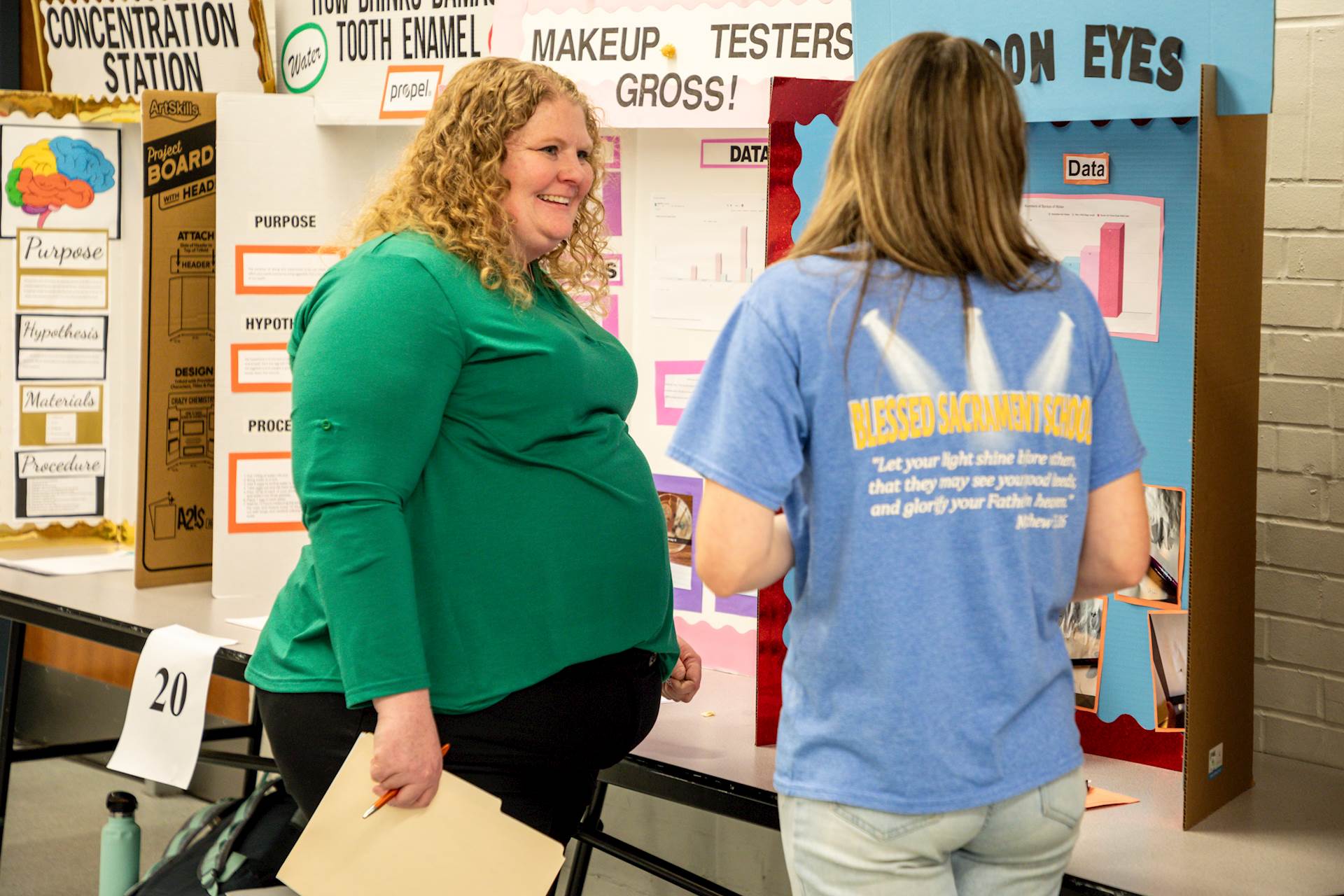 A Hanson employee talks with a Blessed Sacrament seventh-grade student about her science fair project.
A Hanson employee talks with a Blessed Sacrament seventh-grade student about her science fair project.
What type of sandbag material will best stop a flood? Does banana water work well as a fertilizer? These and many other questions were posed and answered Feb. 9 during the judging of the annual science fair at Blessed Sacrament School (BSS) in Springfield, Illinois.
Since 2014, engineers and scientists from Hanson’s Springfield office have visited Blessed Sacrament to serve as judges for the variety of science fair topics and exhibits researched and built by the school’s seventh graders.
‘Real-world career choices’
Laura Reiser, science and computer teacher at BSS, starts her students’ science fair thought process early in the school year, walking them through the many steps between idea and finished project.
“They study the scientific method, and they design an experiment based on that model,” Laura said, explaining that each student is required to start with a purpose and create a testable hypothesis. Each experiment must have at least two independent variables with a minimum of three trials per test group.
“This project also teaches the students organizational skills and time management,” she continued. “Presenting the project to an audience allows the students the opportunity to develop their public speaking skills, and presenting to professional engineers and scientists who are experts in their field helps the students see how their science projects translate into real-world career choices.”
Committed to the next generation
Hanson Water/Wastewater Discipline Manager Lee Bloome, P.E., has assisted with the science fair judging since Hanson began participating in 2014. The following year, he helped organize the event, and he’s been coordinating it ever since.
“I’m drawn back year after year to see how the next generation is doing,” Lee said. “In this day and age of employee shortages, anything we can do to encourage science, technology, engineering and math careers is important.”
Lee said he also participates as a tribute to his first wife, Lisa, who passed away in 2017 and was a fourth-grade teacher at the school. “Being at BSS brings back memories of her tenure there,” he said.
Wash your hands!
As a parent, the opportunity to interact with the students has drawn Jeff Bushur, Hanson’s environmental assessment discipline manager, to judge at the event for many years.
“I like to encourage interest in science and objective fact-finding in children,” he said. “It’s fun to see the kids’ creativity in their project displays. Some display boards we’ve seen have been top-notch, grabbing your attention as you walk up.”
As a former health inspector, Jeff was drawn to a project for which a student tested different durations of handwashing. He recalled that the student had performed multiple trials of no handwashing as well as 5-, 10- and 20-second intervals of handwashing.
“Then she counted bacterial colonies that populated on agar petri dishes after having swabbed the handwasher’s hands and inoculated the petri dishes,” he said. “The no-handwashing dish was disgusting!”
Water contaminants and nail polish
A different type of project involving hands stood out to Lee at this year’s judging.
“One student performed an experiment to determine which water source has the least amount of contamination,” he said, adding that the student’s experiment was methodical and the number of samples numerous. The student had collected samples from many communities with the help of his mother, who travels for her job, and his furthest sample was from Ann Arbor, Michigan.
“He was very consistent in the testing and did quite a bit of research on the types of contaminants in water,” Lee said. “I was able to impart some knowledge on the different constituents in the water and how some of them were not harmful. He was very confident in reporting on his experiment and had developed a well-cited and complete report.”
Lee recalled another memorable project from the past. “It was about the resiliency of nail polish,” he said. “They had a very scientific and consistent method of testing the durability of various nail polish brands using artificial nails that came in a circular pattern and spinning them against an abrasive using a drill.”
What makes a winner?
Winning science fair projects advance to a regional competition, but what makes a winning project? According to Lee, “a winning project needs to test one or two variables with multiple rounds of testing for consistency and have a clear hypothesis and conclusion.”
Jeff said one thing he looks for in the projects he judges is the students’ ability to present.
“Sound scientific steps and experimental error control are important, of course,” he said, “but what can really make a project great is eye contact, slow vocal pace and engaging the judge while answering questions. Many of these kids are scared and nervous, and I think all the judges try to calm them as much as possible. The fair is a great opportunity for these students to practice their public speaking.”